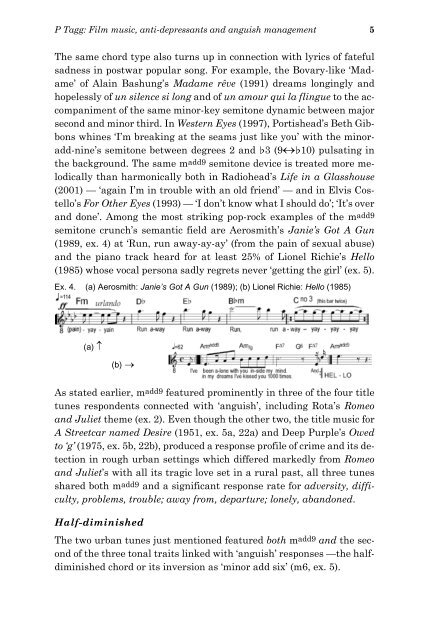Film music, antidepressants and anguish management - Philip Tagg
Film music, antidepressants and anguish management - Philip Tagg
Film music, antidepressants and anguish management - Philip Tagg
You also want an ePaper? Increase the reach of your titles
YUMPU automatically turns print PDFs into web optimized ePapers that Google loves.
P <strong>Tagg</strong>: <strong>Film</strong> <strong>music</strong>, anti-depressants <strong>and</strong> <strong>anguish</strong> <strong>management</strong> 5<br />
The same chord type also turns up in connection with lyrics of fateful<br />
sadness in postwar popular song. For example, the Bovary-like ‘Madame’<br />
of Alain Bashung’s Madame rêve (1991) dreams longingly <strong>and</strong><br />
hopelessly of un silence si long <strong>and</strong> of un amour qui la flingue to the accompaniment<br />
of the same minor-key semitone dynamic between major<br />
second <strong>and</strong> minor third. In Western Eyes (1997), Portishead’s Beth Gibbons<br />
whines ‘I’m breaking at the seams just like you’ with the minoradd-nine’s<br />
semitone between degrees 2 <strong>and</strong> $3 (9↔$10) pulsating in<br />
the background. The same madd9 semitone device is treated more melodically<br />
than harmonically both in Radiohead’s Life in a Glasshouse<br />
(2001) — ‘again I’m in trouble with an old friend’ — <strong>and</strong> in Elvis Costello’s<br />
For Other Eyes (1993) — ‘I don’t know what I should do’; ‘It’s over<br />
<strong>and</strong> done’. Among the most striking pop-rock examples of the madd9<br />
semitone crunch’s semantic field are Aerosmith’s Janie’s Got A Gun<br />
(1989, ex. 4) at ‘Run, run away-ay-ay’ (from the pain of sexual abuse)<br />
<strong>and</strong> the piano track heard for at least 25% of Lionel Richie’s Hello<br />
(1985) whose vocal persona sadly regrets never ‘getting the girl’ (ex. 5).<br />
Ex. 4. (a) Aerosmith: Janie’s Got A Gun (1989); (b) Lionel Richie: Hello (1985)<br />
(a) ↑<br />
(b) →<br />
As stated earlier, madd9 featured prominently in three of the four title<br />
tunes respondents connected with ‘<strong>anguish</strong>’, including Rota’s Romeo<br />
<strong>and</strong> Juliet theme (ex. 2). Even though the other two, the title <strong>music</strong> for<br />
A Streetcar named Desire (1951, ex. 5a, 22a) <strong>and</strong> Deep Purple’s Owed<br />
to ‘g’ (1975, ex. 5b, 22b), produced a response profile of crime <strong>and</strong> its detection<br />
in rough urban settings which differed markedly from Romeo<br />
<strong>and</strong> Juliet’s with all its tragic love set in a rural past, all three tunes<br />
shared both madd9 <strong>and</strong> a significant response rate for adversity, difficulty,<br />
problems, trouble; away from, departure; lonely, ab<strong>and</strong>oned.<br />
Half-diminished<br />
The two urban tunes just mentioned featured both madd9 <strong>and</strong> the second<br />
of the three tonal traits linked with ‘<strong>anguish</strong>’ responses —the halfdiminished<br />
chord or its inversion as ‘minor add six’ (m6, ex. 5).














